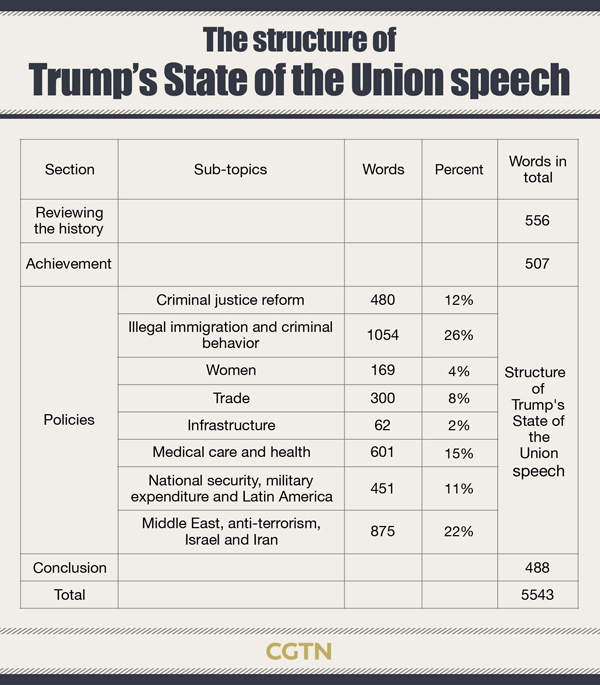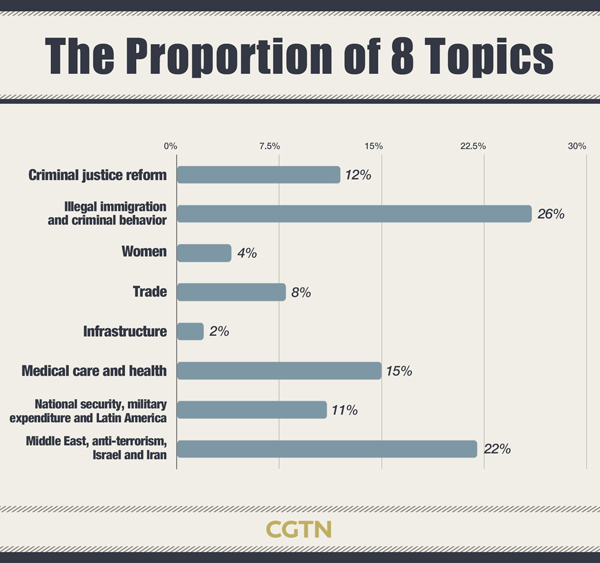Major Power Relations
Your Present Location: PROGRAMS> Major Power RelationsWang Peng: Domestic priorities reigned in Trump's State of the Union address
By Wang Peng Source: CGTN Published: 2019-2-7
U.S. President Donald Trump's second formal State of the Union address took place on February 5. As American media noted, this speech was delayed by two weeks amid the longest government shutdown in history and it took place as the president and Congress were trying to find a solution to avert another shutdown on February 15.
In the speech, President Trump stated, “Together we can break decades of political stalemate. We can bridge old divisions, heal old wounds, build new coalitions, forge new solutions, and unlock the extraordinary promise of America's future. The decision is ours to make.”
Certainly, the real effectiveness of breaking “political stalemate” and bridging “old divisions” still remains to be seen.
The structure of Trump's State of the Union speech
The transcript of Trump's speech suggests there are roughly four parts: The beginning reviews America's 20th century history to arouse the pride and glory of American citizens; the second part reviews the achievements of the Trump administration during the past two years with unreserved self-praise; the third as the main body of his speech demonstrates eight major policies that President Trump has implemented; and the final concluding part summarizes the speech as a whole and calls on the American people to follow him to “rekindle the bonds of love and loyalty and memory that link us together as citizens, as neighbors, as patriots,” “keep freedom alive in our souls,” “keep faith in America's destiny,” and “choose greatness.”
Parts I, II and IV each take one-tenth of the total length, while the main body occupies 70 percent. In part III, Trump demonstrates eight major policy successes, namely:
(1) Criminal justice reform: In this starting point, Trump cites recent legal cases such as the highly publicized one involving Alice Johnson to illustrate his efforts and achievements in reforming the American legal system (e.g. signing the First Step Act into law).
(2) Illegal immigration and criminal behavior: This section is a key focus of Trump's speech, accounting for 1,054 words and 26 percent of the main body text of 3,992 words. It is not difficult to understand his emphasis on the horrible harm innocent Americans suffered in the past that, in his view, was caused by illegal immigrants and their criminal behavior. As a result, he calls for both Democrats and Republicans in Senate and House to support his Copernican plan – building a wall to separate America from Mexico.
(3) Women: (Perhaps) in an effort to respond to increasing criticisms of his treatment of women, the president is eager to prove his willingness to reach out to female American voters and espouse a great contribution to women's rights protection.
(4) Trade: Trump mentioned China/Chinese four times in this section, and repeated a number of tedious “accusations” such as “targeting our industries,” “stealing our intellectual property,” and “theft of American jobs and wealth” to legitimize his trade war.
(5) Infrastructure: In a short paragraph,Trump uses 62 words to say that “both parties should be able to unite for a great rebuilding of America's crumbling infrastructure.”
(6) Medical care and health: In this section, Trump carries forward his great tradition of “anything but Obama” by criticizing his predecessor's “medical care” system and praising his own reform.
(7) National security, military expenditure, and Latin America: Sections 7 and 8 are about international affairs and American foreign policy, which in total occupy one-third of the main body. Trump firstly introduces the situation of American national security and the contribution made by his administration in brief; then seeks to justify his decision to increase military expenditure.
(8) The Middle East, anti-terrorism, Israel and Iran: This section is the paramount one among all Trump's words on international and regional affairs. The length of this section (22 percent) is next only to “Illegal immigration” (26 percent). Following his statement above, Trump turns to the issue of the war against terrorism; and then “naturally” repeats his accusation that the Iranian government is “a regime that chants death to America and threatens genocide against the Jewish people.”


Looking broadly at President Donald Trump's second formal State of the Union address, it can be seen clearly that: First, domestic affairs (due to the “America First” principle) are of paramount importance. It is beyond any doubt that Trump's speech carried the slogan “We must be united at home to defeat our adversaries abroad.” This part captures more than two-thirds of Trump's words and time to demonstrate his policy and prove the “great contribution” made by his administration for the American people.
Second, China is mentioned in a negative way, though not very sharply.
Third, Middle East affairs occupy an important place in the Trump administration's current foreign policy. His highly biased Middle East policy unreservedly supports the special U.S.-Israel relationship and underlines the “sin” and “threat” of Tehran, through the perspective of “principled realism” he strongly backs up. President Trump's “extraordinary” and explicit policy preference may provide opportunities for other great powers in their upcoming regional and global “game of thrones.”
Wang Peng is an associate research fellow at the Chongyang Institute for Financial Studies, Renmin University of China, and a researcher at the Charhar Institute.























































































 京公网安备 11010802037854号
京公网安备 11010802037854号





